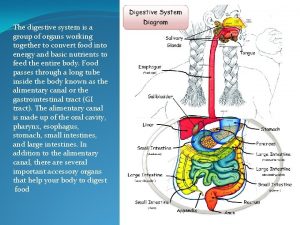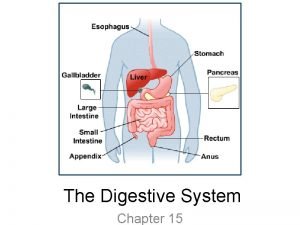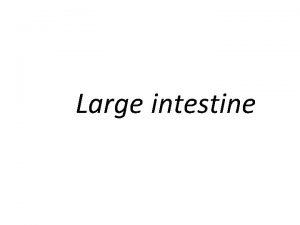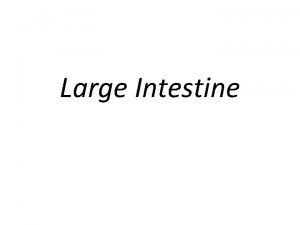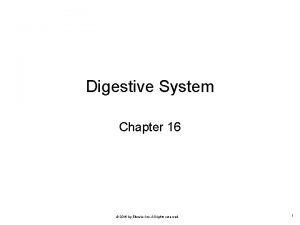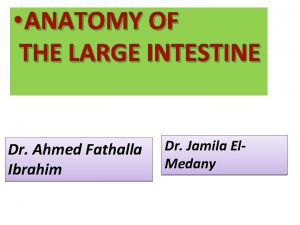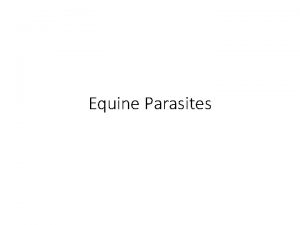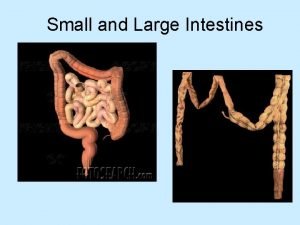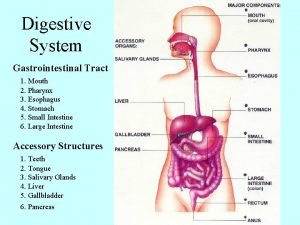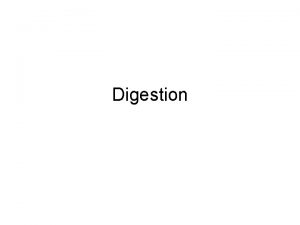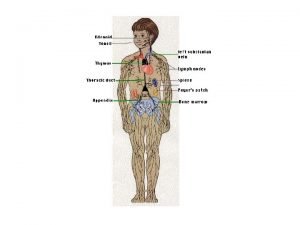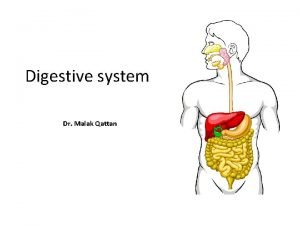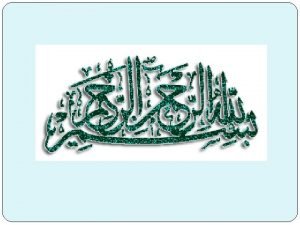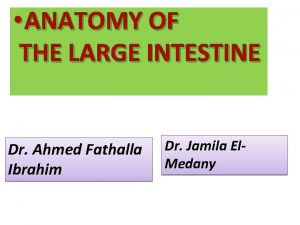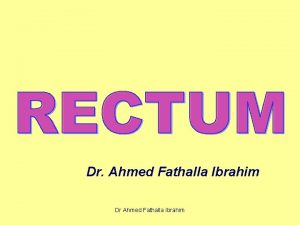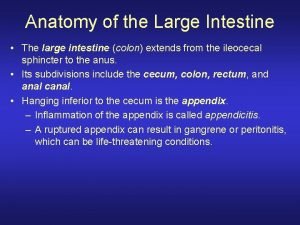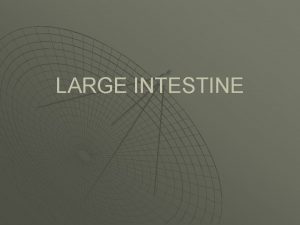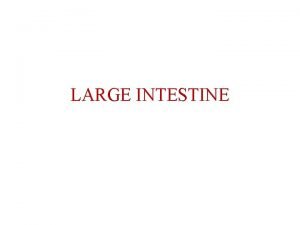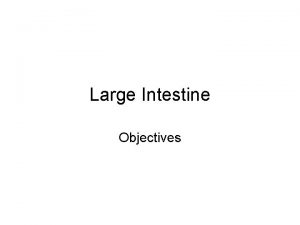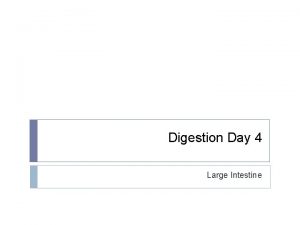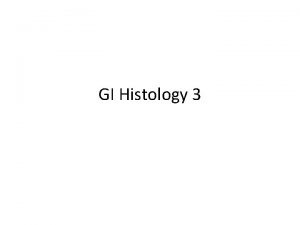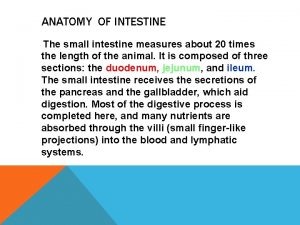ANATOMY OF THE LARGE INTESTINE Dr Ahmed Fathalla




















- Slides: 20

• ANATOMY OF THE LARGE INTESTINE Dr. Ahmed Fathalla Ibrahim Dr. Jamila El. Medany

OBJECTIVES At the end of the lecture, students should: q. List the different parts of large intestine. q. List the characteristic features of colon. q. Describe the anatomy of different parts of large intestine regarding: the surface anatomy, peritoneal covering, relations, arterial & nerve supply.

Parts of Large Intestine q CECUM q APPENDIX q ASCENDING COLON Abdomen q TRANSVERSE COLON q DESCENDING COLON q SIGMOID COLON Pelvis q RECTUM q ANAL CANAL Perineum ABDOMEN PELVIS PERINEUM

Characteristics of COLON (NOT FOUND IN RECTUM & ANAL CANAL 1. Taeniae coli: (3) longitudinal muscle bands 2. Sacculations (Haustra): Because the Taeniae coli are shorter than large intestine 3. Epiploic Appendices : Short peritoneal folds filled with fat

Peritoneal Covering q PARTS WITH MESENTERY: 1. Transverse colon 2. Sigmoid colon 3. Appendix 4. Cecum q RETROPERITONEAL PARTS: 1. Ascending colon 2. Descending colon 3. Upper 2/3 of rectum

Peritoneal Covering PARTS DEVOID OF PERITONEAL COVERING: 1. Lower 1/3 of rectum 2. Anal canal Rectum Anal canal

Anterior Relations of (CECUM – ASCENDING & DESCENDING COLONS) q. Greater omentum q. Coils of small intestine q. Anterior abdominal wall

Posterior Relations (CECUM – ASCENDING & DESCENDING COLONS) q. Cecum: 1. Psoas major 2. Iliacus q. Ascending colon: 1. Iliacus 2. Quadratus lumborum 3. Right kidney. q. Descending colon: 1. Left kidney 2. Quadratus lumborum 3. Iliacus Quadratus lumborum

COLIC FLEXURES Position: higher Angle: more acute Hepatic flexure Splenic flexure

Relations of Transverse Colon Anterior: greater omentum, anterior abdominal wall Posterior: 2 nd part of duodenum , pancreas & superior mesenteric vessels.

Relations of Transverse Colon Superior: liver, gall bladder, stomach Inferior: coils of small

APPENDIX • Surface anatomy: • the base of appendix is marked by Mc’Burney’s point: • A point at the junction of lateral 1/3 & medial 2/3 of a line traced from right anterior superior iliac spine to umbilicus

APPENDIX Opening: At posteromedial aspect of cecum, 1 inch below ileo-cecal junction q Positions: 1. Retrocecal : (most : common) 2. Pelvic 3. Subcecal 4. Preilieal 5. Postileal: least common q q (4) (5) (1) (2) (3)

RECTUM q. Beginning: as a continuation of sigmoid colon at level of S 3. q. Termination: continues as anal canal, one inch below & in front of tip of coccyx. Its end is dilated to form the rectal ampulla. q. Length: 13 cm(5 inches)

Relations of Rectum in Pelvis MALE PELVIS q. Anterior: seminal vesicles, posterior surfaces of urinary bladder & prostate gland q. Posterior: sacrum, sacral plexus & coccyx R FEMALE PELVIS q. Anterior: posterior wall of vagina q. Posterior: sacrum , sacral plexus & coccyx R

Relation Between Embryological Origin of GIT& its Arterial Supply

VENOUS DRAINAGE OF GIT • The veins of the gut form the tributaries of the portal vein which enters the liver and drains into the portal circulation.

Lymph drainage of GIT • The lymph vessels follow the arteries. • Ultimately, all the lymph is collected at the Preaortic lymph nodes (Superior & Inferior mesenteric).

RELATION BETWEEN EMBRYOLOGICAL ORIGIN & NERVE SUPPLY q Origin: Midgut (endoderm) q Nerve supply: (Autonomic): • Sympathetic + Vagus q Origin: Hindgut (endoderm) q Nerve supply: (Autonomic): • Sympathetic + pelvic splanchnic nerves q Origin: ectoderm (lower 1/3 of anal canal) q Nerve Supply: Somatic (inferior rectal)

THANK YOU
 Ahmed fathalla
Ahmed fathalla Esophagus stomach small intestine large intestine
Esophagus stomach small intestine large intestine Label the large intestine
Label the large intestine Main function of small intestine
Main function of small intestine Large intestine anatomy
Large intestine anatomy Sacculations
Sacculations Ahmed muhudiin ahmed
Ahmed muhudiin ahmed Part of large intestine
Part of large intestine Divisions of the large intestine
Divisions of the large intestine Right colic flexure
Right colic flexure Strongylus vulgaris
Strongylus vulgaris Diareherra
Diareherra Large intestine function in digestive system
Large intestine function in digestive system Characteristics of water soluble vitamins
Characteristics of water soluble vitamins Pharynx
Pharynx Digestive system enzymes chart
Digestive system enzymes chart Lymphoid tissue in large intestine
Lymphoid tissue in large intestine Large intestine function
Large intestine function Appendix omentalis
Appendix omentalis The main jobs of the large intestine are _____.
The main jobs of the large intestine are _____. Regions of large intestine
Regions of large intestine

